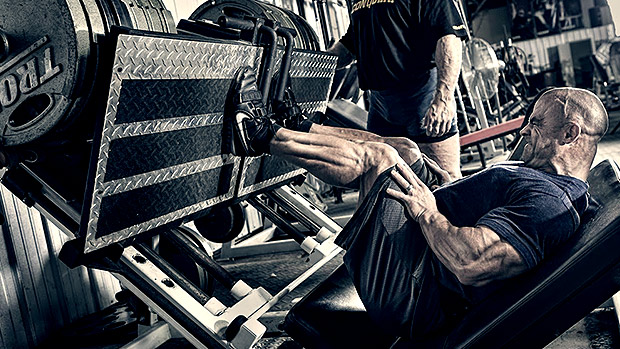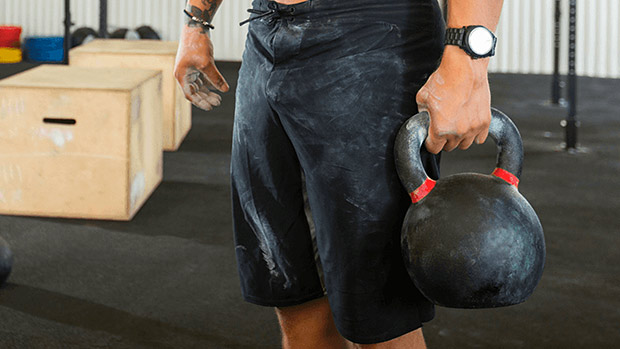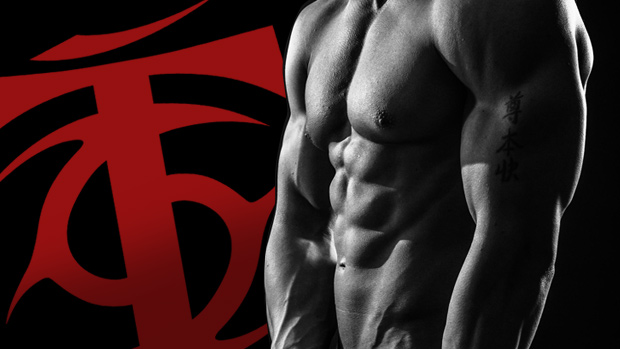We had a fun idea: Send nine of our experts a fill-in-the-blank question to pick their brains. Here's how they answered it.
The Question

- Cut out: The easy stuff
- Add in: Hard-ass work
We humans are hardwired to avoid pain and seek pleasure. But to earn a physique that looks extraordinary and performs extraordinarily well, you must take the hard road and do extraordinary things.
For example, it's easy to eat sugary cereal as your source of carbs – your brain literally derives pleasure from it. It's hard to opt for a plain baked potato instead because there's no immediate reward.
It's easy to do a set of leg extensions, stopping just as you begin to feel the burn. It's hard to squat with a heavy barbell on your back until you can't do another rep. Lat-pulldowns are easy. Deadlifts are tough. Walking on the treadmill is easy. Doing legitimate HIIT that leaves you gasping for air is hard.
It's easy to grab some fast food, too. But it takes discipline to plan ahead and cook and weigh the proper portions of chicken breasts, rice, fresh vegetables, and almonds.
Making a training or nutrition plan is easy. Following through on that plan for weeks and months on end is tough.
To make progress, you simply have to be able to delay gratification, embrace pain and inconvenience, and be willing to do what others are not. – Clay Hyght
- Cut out: Mindless entertainment
- Add in: More sleep
This is the part where I'll inevitably come across as the cantankerous old man always yelling at people to get off his lawn. But you'd make much more progress if you cut out Netflix, Fortnite, and websites dedicated to Game of Thrones predictions. Instead, go to bed.
Your workouts are only as effective as how well you allow yourself to recover. If you're binge watching TV or debating DragonstoneDaenerys1318 on some message board until 2AM every night, you shouldn't be surprised about not making progress in the gym.
Whenever I sit down with an athlete who's lost his training mojo or has been stuck in a rut, the first thing we'll discuss is his sleeping habits, or lack thereof. We'll discuss his nightly rituals and try to come up with some alternatives to help with his "sleep hygiene." You know, putting away the electronics, reading a book, using white noise, getting the room as dark as possible, etc.
Many times it's the nightly ritual that needs tweaking. The body needs a little nudge to remind itself to wind down and prepare for a good night's sleep. That's hard to do if you're jacked up after playing forty-three rounds of Mario Kart.
That's still a cool game, right? See! I'm old. – Tony Gentilcore

- Cut out: Trendy diets
- Add in: Tracking your calories
Sure, some trendy diets work, but for the most part they're just fancy marketing tactics and don't provide a sustainable plan to transform your body. So stop jumping on trendy nutrition trends and stick with proven principles, like counting your calories.
You can only measure what you can manage. Tracking your calories ensures you're doing the most important thing: eating enough to build muscle, or staying in a calorie deficit to lose fat.
Tracking gives you a measurable benchmark. Without tracking, we're closing our eyes and shooting at a target in the dark... and the majority of folks have no idea where that target is in the first place.
Everyone should track for 60 to 90 days to learn portion sizes. (Do it at least once.) If you want to continue afterward, go for it. Tracking calories gives you awareness. Without awareness, you can't make better choices.
The two tablespoons of olive oil you cooked your spinach in last night? It had more calories than the chicken breast on your plate. The spoonful of peanut butter you down with a late night snack? It contains more calories than the apples outlawed on the latest high-fat, fructose-banning diet.
You can only optimize actions you're aware of. This is where calorie counting comes in: giving you the ultimate insight into calorie balance, macronutrient splits, and any gaps in your nutrition.
Sure, calorie counting isn't perfect, but it's a proven method. The ten minutes it takes each day to track will give you the awareness and discipline to improve your eating for the rest of your life. – Eric Bach
- Cut out: Subtle ego lifting
- Add in: True strength building
When you hear the term "ego lifting" you probably think of one-fourth squats, curls that use everything but biceps, and bench presses that double as the spotter's deadlift workout.
As a T Nation reader, you know better. However, you can easily fall prey to a more subtle version of ego lifting where you train at or too close to your 1RM.
This is especially common with the bench press and deadlift. A lifter trains hard and can eventually hit a plate milestone. It might be a three-plate bench press or a four-plate deadlift with proper form. Now he's hooked.
Each time he trains that lift, he wants that feeling again (and wants everyone in the gym to see him). As a result, his training session consists of working back up to that 1, 2 or 3RM. A typical deadlift workout might look like this:
- Set 1: 5 x 135
- Set 2: 3 x 225
- Set 3: 2 x 315
- Set 4: 1 x 365
- Set 5: 1-2 x 405
The problem with subtle ego lifting is that the intensity is too high. This can easily lead to burnout, plateaus, and injury. The other problem? The volume is too low to actually build muscle and achieve long-term strength gains.
If you're serious about results, swap subtle ego training for true strength building. True strength building is when you...
- Check your ego at the door
- Come to the gym to build strength, not to demonstrate it
- Lift heavy, but not maximal, weights
- Train hard, but leave a rep or two in the tank each set
- Use a moderate, repeatable amount of volume (3x5, 5x5, 4x6, 3x8, 5-8x3)
- Work on your weaknesses
A true strength training deadlift workout might look like this:
Warm-up sets:
- Set 1: 5 x 135
- Set 2: 3 x 225
- Set 3: 2 x 275
- Set 4: 1 x 315
- Set 5: 1 x 345
Work sets:
- 2-3 sets of 5 reps with 365
This may not seem as cool at first, but this is a very easy way to add 5-10 pounds per week for quite a while. Before long you'll be doing a perfect set of 5 with your old 1RM. – Andrew Heming

- Cut out: Excessive research
- Add in: In-the-trenches training experience
This may sound odd coming from an educated coach, but constantly keeping your nose buried in the pages of theoretical strength training, physiology, and programming books can create two distinct disadvantages for lifters:
- It can leave them in constant search of the "best method."
- It can create analysis paralysis, where every exercise or program becomes contraindicated with "justifiable" scientific reasoning and study-based references to back it up.
Anyone who's impressively well built or has freakishly strong numbers in the gym certainly devoted time to studying and learning about the science of lifting. But they devoted ten times more of their time to getting into the gym to apply the knowledge – and more importantly, to learn their bodies.
Research is good for you, but if you're a 150-pound lifter with a 185 pound deadlift who's emailing strength coaches about whether or not switching from supramaximal holds to post-activation potentiation techniques will lower neurological output for the remainder of the workout... well, you've gotta get a grip and just focus on training hard consistently.
Also, keep in mind that you may learn best when someone's actually teaching you, not from some book or online study. If you're really serious about your gains, you'll make the investment to hire a respected coach. Let someone more experienced handle the programming piece for you so all you have to do is listen, learn, apply, and turn into a beast. – Lee Boyce
- Cut out: Workout randomness
- Add in: Program consistency
All that porn isn't helping you. We live in a world of free thrills and information at our fingertips. A quick search will bombard you with millions of training and diet options.
At T Nation alone you have hundred of plans written by some of the finest coaches in the world. There are so many great training options that it can be hard to pick just one program and stick to it.
But if you want to make great progress, find a program that's aligned with your goals and follow it. Not just for a day, not just a week or two, but for the entire duration of that program: 4 weeks, 12 weeks, whatever.
Make notes about what you liked and didn't like, how your body held up, and the results you saw. Learn the program, master it, and adjust it as needed. Get the most out of it before you move on. – Gareth Sapstead
- Cut out: What you want to do
- Add in: What you need to do
We're all occasionally guilty of skipping the leg, back, and mobility work needed to craft a balanced and impressive physique. We sometimes neglect the small detailed work that keeps the joints strong and mobile. It's easy to leave out the stuff that complements the big lifts and allows us to train hard week in and week out.
Admit it, you often go straight for the racks and load up. Instead, work through some added warm-up sets and do some face-pulls and band pull-aparts for your shoulders.
And guys, add some glute work. We need it more than the girls do, especially if you sit at a desk all day. No, don't waste half an hour foam rolling, but be thorough with your warm-up sets and mix in some mobility drills between sets.
Caring about joint health and mobility adds years of quality training. Control appropriate load through the full available range of motion. Deload when your body feels beaten up. You'll stop losing days to injuries, and you can train harder more often. – Andrew Coates

- Cut out: Looking for the magic bullet
- Add in: Proven exercise programming
A "magic bullet" in this case is that mystical training method that will change everything and give you everything you want. Problem: It really doesn't exist.
Instead, realize that successful exercise programming, regardless of your training goal, hinges on the same three key elements: specificity, individuality, and consistency.
Program design continues to confuse people. Too many of us don't search for the key elements of successful programming and instead look for the shiny magic bullet. This demand has brought on an explosion of exercise programming info that, instead of producing simplicity and clearer understanding, has produced more complexity and confusion.
All these different program design models and concepts have come together to form what seems like a complex mathematical formula we assume only university professors can comprehend.
Although some so-called experts try to make program design sound like you're realigning a satellite, it's really very simple. Regardless of your training goal, effective exercise programming hinges on those three key elements:
1 Specificity
That means you get what you train for. Just like you've got to get wet if you want to learn how to swim well, if you want to become more explosive (improve movement speed), then use explosive exercises (total-body power exercises).
If you want to improve strength, incorporate some training with heavier loads. If you want to improve your rotational ability for a rotary-oriented sport, use a variety of rotational exercises at various speeds and loads.
Your goals ultimately determine the exercises that need to be a part of your workout routine. And remember, you achieve what you emphasize. So, spend more training time working on the areas that are most aligned with your goal.
2 Individuality
Don't fit yourself to exercises; fit exercises to your body based on how you move, your injury history, etc. Individuality also means not fitting yourself into certain training programs and schedules, but rather choosing them based on your preferences and personal schedule. You're more likely to adhere to a realistic program you're interested in doing.
3 Consistency
The main building block you need for continued success is consistent effort. Be patient, be realistic, and be consistent. When you continue to lay a foundation of effort, you can build just about anything on it. – Nick Tumminello
- Cut out: The focus on the tools used for exercise
- Add in: More focus on your body
A typical issue is too much attention being paid to where and how the tools move, rather than on the human mechanics that get the tools there in the first place.
For example, in a barbell deadlift the bar goes up and then down again... but you are not the bar. Too much emphasis on pulling the bar up is a common error that leads to overloading the lumbar spine and under-using leg drive, which can lead to injury.
Similarly, in a barbell back squat, the bar drops straight down and returns up, but the squatter shouldn't be thinking about dropping straight down, because again, he or she is not the bar. Instead, they ought to focus on sitting the hips back and spreading the knees apart and forward, which creates the vertically descending bar path. And the hips push forward and up diagonally to return to the start position, not straight up.
Applying this logic to all movements will help lifters obtain more optimal movement patterns, and therefore improved muscular activation and lower injury risk. – Susy Natal





